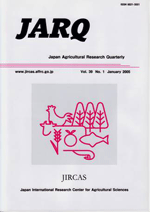Effect of the Interaction Between Monsoon Currents and Waves on the Morphological Processes along the Mekong River Delta Coast
| ISSN | 00213551 |
|---|---|
| NII recode ID (NCID) | AA0068709X |

One of the longest rivers in the world, the Mekong River flows through eight estuaries into the East Sea off Vietnam. In recent decades, the complex morphological evolution of the Mekong River Delta coast has affected the livelihoods of local people and the development of Vietnam’s major economic area in the south. In this study, large-scale numerical models were created to simulate the long-term morphological processes along the Mekong River Delta coast. By using these models, key factors such as river currents, tides, sediment discharge, monsoon currents, waves, and salinity were calculated under various conditions, including seasonal variations of river flow, monsoon surface sea currents, and waves. The results show that the river flow rate determines erosion and deposition in the river. Furthermore, the river current combined with tidal current governs the development of narrow passages and islets. The effect of the interaction between the monsoon current and waves on the morphological processes of the coastline is significant. The monsoon current plays a major role in changing the shoreline, whereas wave action is a secondary factor that intensifies shoreline erosion, which is primarily influenced by sea current.
| Date of issued | |
|---|---|
| Creator | Thanh LETRUNG Trieu Anh NGOC Kazuaki HIRAMATSU |
| Subject |
Sediment transport morphological evolution Mike 21 Coupled FM |
| Available Online | |
| NII resource type vocabulary | Journal Article |
| Volume | 50 |
| Issue | 2 |
| spage | 121 |
| epage | 133 |
| DOI | 10.6090/jarq.50.121 |
| Rights | Japan International Research Center for Agricultural Sciences |
| Relation | 異版である : J-STAGE |
| Language | eng |
